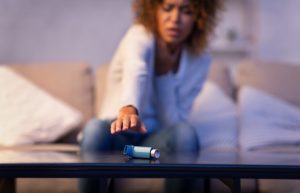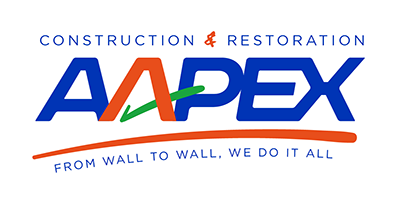Residential ozone cleanings are often needed in restoration projects in order to mitigate lingering odors stemming from fire or water damage. Since the onset of the COVID-19 pandemic, homeowners are now significantly concerned about sanitizing the interior of their homes in an effort to prevent the spread of disease. Ozone generators have been available on the open market for several years, but the new focus on cleanliness has inspired many homeowners to consider investing and performing cleanings themselves. At Aapex Construction & Restoration, we never advise homeowners to attempt to perform an ozone cleaning without a trained professional. Here’s a breakdown of how ozone cleanings work and an exploration of the dangers of DIY ozone cleaning.
How Does Ozone Cleaning Work?
 As the primary component of the ozone layer, ozone in the stratosphere protects us from the sun’s harmful UVB radiation and is essential for making life on Earth possible. However, unlike the oxygen we breathe down on the ground, which is composed to two oxygen atoms, ozone is an unstable compound composed of three oxygen atoms. The bond between these atoms is easily broken, allowing two atoms to join together as O2 and leaving one O to join with other unstable compounds and dissipate. This process, known as oxidation, neutralizes pollutants and odors, leaving behind a fresh, clean environment. When homeowners throw open the windows after a storm to get some “fresh air” through the house, they are actually doing a natural ozone cleaning on a micro scale. The electricity from thunderstorms splits O2 molecules apart and creates a temporary charge that encourages the formation of ozone. Many people say they can smell a storm coming or going – this “smell” is the ozone created by the storm.
As the primary component of the ozone layer, ozone in the stratosphere protects us from the sun’s harmful UVB radiation and is essential for making life on Earth possible. However, unlike the oxygen we breathe down on the ground, which is composed to two oxygen atoms, ozone is an unstable compound composed of three oxygen atoms. The bond between these atoms is easily broken, allowing two atoms to join together as O2 and leaving one O to join with other unstable compounds and dissipate. This process, known as oxidation, neutralizes pollutants and odors, leaving behind a fresh, clean environment. When homeowners throw open the windows after a storm to get some “fresh air” through the house, they are actually doing a natural ozone cleaning on a micro scale. The electricity from thunderstorms splits O2 molecules apart and creates a temporary charge that encourages the formation of ozone. Many people say they can smell a storm coming or going – this “smell” is the ozone created by the storm.
Professional ozone cleanings work in much the same way, but by using much higher concentrations of ozone. By producing a controlled electrical current, professional ozone cleanings help purify the air inside your home and eliminate persistent odors. Most effective at removing the odors left in the wake of tobacco use, fire damage, and mold or mildew, ozone cleanings also help sanitize your home. Ozone destroys microorganisms and pollutants at their source by creating a chemical reaction with the compounds it attaches to, breaking them down at the molecular level. This process, when properly and safely done, is able to eliminate 99.99% of odors, bacteria, and viruses.
The Dangers of DIY Ozone Cleaning
Ozone reacts on a molecular level with organic material, working to eliminate odors, pathogens, and allergens by way of a chemical reaction. Ozone does not discriminate when it comes to the organic compounds it reacts with. It will react as effectively with organic compounds we don’t want to eliminate just as much as those we do. While ozone will work wonders on mold and mildew within your home, it will also react with any other living thing – you or your loved ones, pets, and plants – as well. This molecular reaction can lead to significant health problems for those exposed to high concentrations of ozone. Mild-to-severe health issues can occur from exposure to ozone, potentially causing temporary or permanent lung damage. Exposure to high concentrations of ozone can worsen chronic respiratory issues, like asthma and COPD, and interfere with the body’s ability to fight off respiratory infections. While the effects of ozone exposure vary widely from person to person, the very young, elderly, and those with pre-existing medical conditions are particularly susceptible to complications from ozone exposure.
 Many ozone generators attempt to mitigate these dangers by offering “safe” levels of ozone concentration. Unfortunately, for a cleaning to be effective at sanitizing your home, ozone concentrations far exceeding what is considered safe are necessary. For any homeowner attempting to perform a DIY ozone cleaning, it is nearly impossible to determine the actual concentration levels produced by an ozone generator. Several factors will impact concentration levels, including the square footage of the space being cleaned, the home’s layout and furnishings, etc. In order to ensure the safety of all living things inside your home, a trained professional will need to prep the area beforehand and thoroughly vent the area afterward to return the air to breathable levels. If not properly prepped and mitigated, ozone exposure could have deadly effects on your loved ones, your pets (including your fish), and even your plants.
Many ozone generators attempt to mitigate these dangers by offering “safe” levels of ozone concentration. Unfortunately, for a cleaning to be effective at sanitizing your home, ozone concentrations far exceeding what is considered safe are necessary. For any homeowner attempting to perform a DIY ozone cleaning, it is nearly impossible to determine the actual concentration levels produced by an ozone generator. Several factors will impact concentration levels, including the square footage of the space being cleaned, the home’s layout and furnishings, etc. In order to ensure the safety of all living things inside your home, a trained professional will need to prep the area beforehand and thoroughly vent the area afterward to return the air to breathable levels. If not properly prepped and mitigated, ozone exposure could have deadly effects on your loved ones, your pets (including your fish), and even your plants.
Ozone cleanings are an effective, chemical-free, way of eliminating odors, pathogens, and allergens from all hard and soft surfaces as well as airborne particles. Aapex Restoration & Construction has been using ozone to sanitize our clients’ spaces for a long time. When done right, ozone cleanings are safe in any environment. Contact us today to schedule a consultation.
Related Articles
Ozone Cleaning 101: Purify the Air Inside Your Home
9 Surprising Places Mold May Be Lurking in Your Home
The Importance of Proper Mold Remediation


